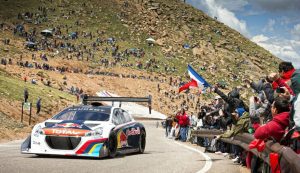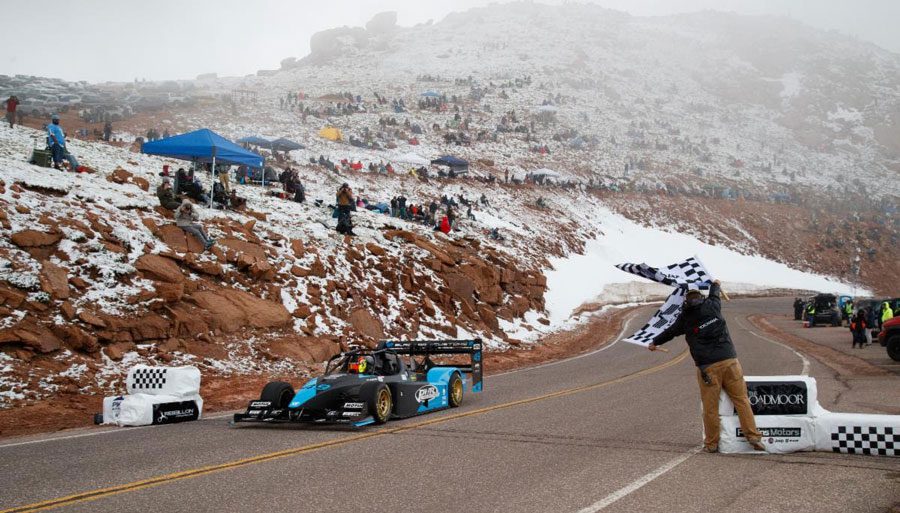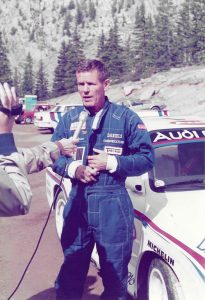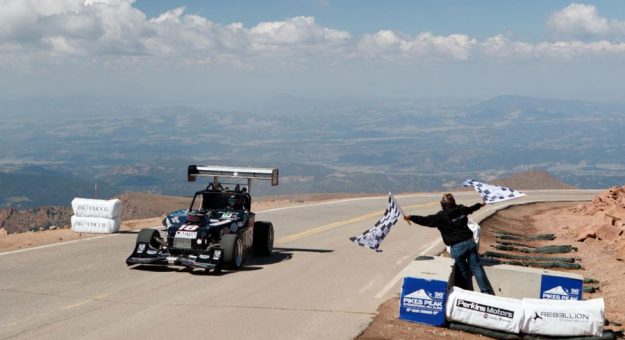Motorsports will achieve a major milestone on Sunday, June 26, when competitors and fans from around the world converge on “America’s Mountain” for the 100th running of the Pikes Peak Int’l Hill Climb.
First held in 1916, the hill climb covers 12.42 miles of the Pikes Peak Highway as competitors navigate 156 turns en route to the 14,115-foot summit of the legendary Colorado mountain.
According to Bob Bodor, executive director of The Broadmoor Pikes Peak Int’l Hill Climb, brought to you by Gran Turismo, here’s how the week-long centennial celebration will unfold. “The beginning of the week has not changed, so we’ll do tech inspection on Monday and we’ll do qualifying runs on Tuesday, Wednesday and Thursday,” Bodor told SPEED SPORT.
“The first big change in the normal week is Thursday evening, June 23, we are hosting a Road to 100 celebration, of which details are still being finalized, but we expect up to a thousand people to attend. It will combine our Hall of Fame inductions and the regular VIP reception that we host every year into a much bigger function that will be our formal kickoff to race weekend.
“June 24 will be the return of Fan Fest, the annual party in downtown Colorado Springs where we close off a pretty significant stretch of city blocks. We have the Red Bull Motorcycle Jumpers coming back for another year. We’ll have the fastest 15 qualified cars on display for fans to check out,” Bodor continued. “There are a bunch of other activities around Fan Fest and that runs from 5 to 9 p.m. on Friday, June 24. There’s a lot of energy around that. It’s always a great event, but unfortunately, we haven’t been able to do it the last two years.
“Then, of course, there’s race day and the 100th running of the race. The race itself won’t have a lot of changes. It’s pretty structured, and we’ll follow protocols. We do have a pretty sizable field of cars that we’ve extended invitations to. As of now, there will be more cars in the field than there have been in recent years, and it’s going to be a busy day on the race track.”
The annual Race to the Clouds has long been a destination event on the American motorsports calendar.

“To me, it starts with ‘America’s Mountain.’ There is no place like Pikes Peak,” Bodor noted. “Anybody who has spent time on the mountain, whether as a racer or a visitor, knows it’s a special place that presents unbelievable challenges. We have one day; one chance to run this race and we have to prepare for all the conditions. Certainly, our race teams, drivers and spectators have to do the same.
“The second thing is tradition, history—the second oldest auto race in the country. The fact we’ve been able to pull off, or will soon be pulling off the 100th race. The legacy of the highway and the fact that it was started by one of the founding fathers of Colorado Springs certainly speaks to that history and tradition,” Bodor said.
“The final thing I would add is the quality of the field. This year alone, it’s an exceptional field. Every year we attract the highest quality field to the hill climb in addition to still incorporating Colorado-based drivers and race teams. That balance among the international, the national and the local racers is another critical element to the event and makes it truly special.”
Bodor and his staff face numerous challenges in hosting a major auto race on a public highway.
“The most logical one is the mountain–the weather, the unpredictability and how quickly things can change from 7 a.m. to noon. It’s not how the weather is when we get ready to start the race, but how does the weather change during the course of the day,” he explained.
“The fact that we have such an interest in the race from fans is fantastic–and I can tell you ticket sales right now are way ahead of where they’ve been in recent years, which speaks to the milestone because everyone wants to be a part of the 100th running.
“But we don’t have huge parking lots that are dedicated to fans. It’s a two-lane road and we have to make do with accommodating those in attendance and making sure they have a great experience. Obviously, the safety of everybody involved is paramount. With a 12.4-mile racetrack winding up through altitude, communication is challenging. Safety is what we think about all day, every day here, and making sure we have all those potential risks covered.”
For both racers and fans, Pikes Peak is a one-of-a-kind opportunity.
“The experience of being in that race community on race day, and even more so during the week leading up to it, and the energy that’s around it is so, so special,” Bodor said. “It’s a combination of the experience itself and the fact people are doing something that only a handful of people get to do, and that’s race a car up Pikes Peak.
“The last part is I believe we put on a great show. We take care of people. We have great respect for anybody who has an interest in the race and it’s been that way since long before I got here,” he added. “We aim to please, to use an old saying. We want spectators to walk off that mountain feeling like it was the greatest day of their lives. We want racers and their crews to feel the same way. There’s flat-out nothing else like it.”
PIKES PEAK INT’L HILL CLIMB FAST FACTS

PIKES PEAK HISTORY
Commissioned by Thomas Jefferson to explore the Great Plains, Lt. Zebulon Pike first spotted Pikes Peak in 1806. As he approached from the east, Pike claimed the majestic mountain would never be climbed by man.
However, by the mid-20th century, Pikes Peak had been conquered by tourists from around the world—by car, motorcycle, bicycle, train, mule, horse and on foot. A carriage road had been built by 1900. Spencer Penrose realized the tourist potential and in 1915 he finished converting the narrow carriage road into the Pikes Peak Highway.
In order to publicize his new road, and draw visitors to his Broadmoor Hotel, Penrose devised a simple plan; run an automobile race to the summit of Pikes Peak. The Pikes Peak Int’l Hill Climb was first run on Aug. 10-12, 1916, with Rea Lentz the winner in a time of 20:55.6.
For more than a century, competitors, race fans and members of the media have converged on Pikes Peak for the annual hill climb. Boasting 156 turns over a 12.42-mile course beginning at 9,390 feet and ending at 14,115 feet above sea level, the timed race is unique.
For many years, the racing surface consisted of both paved and graveled sections, but paving of the road was completed following the 2011 event. In 2018, the current race record, 07:57.148, was set in a prototype electric Volkswagen, with French driver Romain Dumas behind the wheel.
Halted only during WWI and WWII, The Broadmoor Pikes Peak Int’l Hill Climb, brought to you by Gran Turismo, is the second-oldest motorsports event in the United States, behind only the Indianapolis 500.
THE UNSER FAMILY

Prior to becoming the first family of the Indianapolis 500, the Unsers turned the Pikes Peak Int’lHill Climb into their own personal playground. Over a 70-year period starting in 1934, five members of the legendary racing family won the overall King of the Mountain title 26 times.
Bobby Unser heads the list with 10 overall wins followed by Louis Unser (9), Robby Unser (4), Al Unser (2) and Al Unser Jr. (1). There were also numerous class victories along the way.
“I was born in the mountains, I was raised in the mountains and I knew what the mountains were all about,” Bobby Unser said in the June 2014 issue of SPEED SPORT. “When we lived in Albuquerque and were 8 years old, we were going up in the Albuquerque mountains, driving my mother’s car without a driver’s license, obviously, and not legal to drive, fantasizing that it was the Pikes Peak Hill Climb.”
For several years during the 1960s, the hill climb paid points toward the USAC National Championship. Bobby Unser’s victory there in 1968 helped him clinch the title. He earned 25 points to Mario Andretti’s 15 for fourth place.
Unser won the championship over Andretti by a mere 11 points.
NEW LEADER
Late last year, veteran sports executive Bob Bodor was hired as executive director of the Pikes Peak Int’l Hill Climb. The milestone 100th running of the event will be the first under his leadership.
“I was part of the Olympic movement the last seven years, working with the Olympic sport of fencing,” Bodor told SPEED SPORT. “Prior to that I was a college football coach for 25 years and six of those years were coaching at Colorado College. I’ve been a member of the community here in Colorado Springs for right about 20 years. I’m also on the board of directors for the Pikes Peak Marathon and have been for several years, so I’m familiar with the mountain from a trail-running perspective as well.
“I don’t have a motorsports background, but all I’ve done in my professional career is work in sports, whether it be as a coach or now for the last seven of eight years as an administrator,” Bodor added. “I appreciate the mountain in so many ways. I’ve hiked it, I’ve driven up it, I’ve spent time on the summit working with the marathon. It’s a place I’m very, very comfortable with.”
PENROSE HERITAGE MUSEUM
The Penrose Heritage Museum in Colorado Springs, Colo., showcases the history and heritage of the Pikes Peak region through the personal artifacts of Pikes Peak Int’l Hill Climb founder Spencer Penrose and his wife, Julie.
In addition to the hill climb, the Penrose legacy includes the construction of the Pikes Peak Auto Highway (1915), the Broadmoor Hotel (1918), the Cheyenne Mountain Zoo (1926) and the Colorado Springs Fine Arts Center (1936), just to name a few of Colorado Springs’ most iconic attractions.
The museum’s exhibits include several carriages, western cultural artifacts and numerous racecars that competed in the infamous Race to the Clouds.
“There is a history of transportation back in the horse-and-buggy day, and there are vintage automobiles from Spencer Penrose’s collection,” said Bob Bodor, executive director of the Pikes Peak Int’l Hill Climb. “We have a lot of vehicles that are on display on the hill climb side. What I think is great about it is you can be in and out in an hour, and walk out of that museum having a genuine sense of the history, not only of the hill climb, but transportation in general in the PikesPeak region.”
Admission to the museum, which is part of The Broadmoor complex, is free.
NOTABLE FIRSTS
1926: Members of the Unser family, Louis and Joe, participated in the Pike Peak Int’l Hill Climb for the first time.
1953: The Sports Car class was added to the competition roster.
1956: First on-board camera was carried by Paul Kleinschmidt in the Open Wheel class.
1960: Joyce Thompson, competing in the Sports Car division, became the first woman to race up Pike Peak.
1973: Ak Miller drove the first propane-powered car to participate in the hill climb.
1976: The Wells Coyote, which would dominate the Open Wheel category for many years, made its debut.
1981: Joe Ball drove the first electric-powered car to compete at Pike Peak.
1985: Michele Mouton became the woman to set a course record.
1988: Charley Hexom was the first paraplegic to make a solo run up the mountain on race day.
1995: The race distance was shortened for the first time due to weather with competitors taking the checkered flag at Devils Playground.
2011: Nobuhiro “Monster” Tajima, driving a Suzuki SX4, was the first to break the 10-minute barrier.
